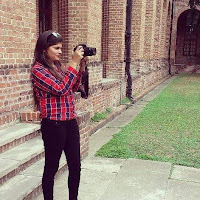SA Travel Diaries:Padam Palace, Rampur Bushahr, Himachal by Deepika Sharma
 |
| Deepika Sharma, Citizen Archaeology Member |
The one thing I have learnt about life is you never know what is planned for you the next moment. Call me a fatalist, but I have had so many instances cementing my belief in fatalism that this particular episode isn't even the first of the many but I am going totalk about it anyway.
Not so long ago, I was on a vacation after finishing Grade 12, the final year of school, spending time in Shimla. It was a peaceful and rather languid phase; that sweet interstice between finishing school and joining a college. Nothing was planned and I liked it that way, especially after all the exams and the stress. And then one day, like a lightening bolt that hits you without warning, a phone call set things in motion for me again. It was my Aunt, and she needed me to pack everything I could possibly want. Why? Because we were headed for a trip! Just like that! (The bolt from the blue analogy wasn't entirely useless, you see? )
What came as an earth shattering surprise and a dilemma of sorts for me at first, soon evolved into one of the best experiences of my life! Our journey, which commenced from Shimla, wove through Rampur, Kinnaur, Rohru, and covered most of the Upper Himachal areas. I had to admit that my personal, languid heaven could not have been half as mesmerising as this.
Brilliant! Good for you! Where is the historical place in the whole narrative that Speaking Archaeologically promises its readers?
 |
| Padam Palace, Rampur, Bushahr |
That's what the trip started with: the Padam Palace in Rampur Bushahr, about a 125 kms from Shimla. It is one of the private residences of Raja Virbhadra Singh, the incumbent Cheif Minister of Himachal Pradesh, who incidentally also hails from the Royal Family of Bushahr.The Palace is not open for commoners without prior permission so, imagine my luck, that we could visit it, because we did have permission!
What took me at the very outset was the unique blend of Indian impact and European style in the architecture of Padam Palace, which is named after Raja Padam Singh, the ruler who began its construction in 1919. It took 6 years to build this double storied building made of wood and (interestingly) black gram. (Yes, I know it's a strange thing but instead of cement black gram was used asmortar in most palatial buildings once upon a time in India.) The building thus, remains true to its Indo-Saracenic style in both architecture and construction, combining conical roofs and Belgian glasswork with the native architectural styles.

Inside the Palace, there is a rich library whose walls are adorned with portraits of the Royals. There are, also, however heads of dead bears and boars on the walls, which can appall you, or completely take you by surprise!
I felt like a time traveller that day; like someone who had gone through a time warp into the era of the Royals and words cannot describe the enchantment that the place held over me, so, I will stop now and let the pictures do the talking.



Comments
Post a Comment